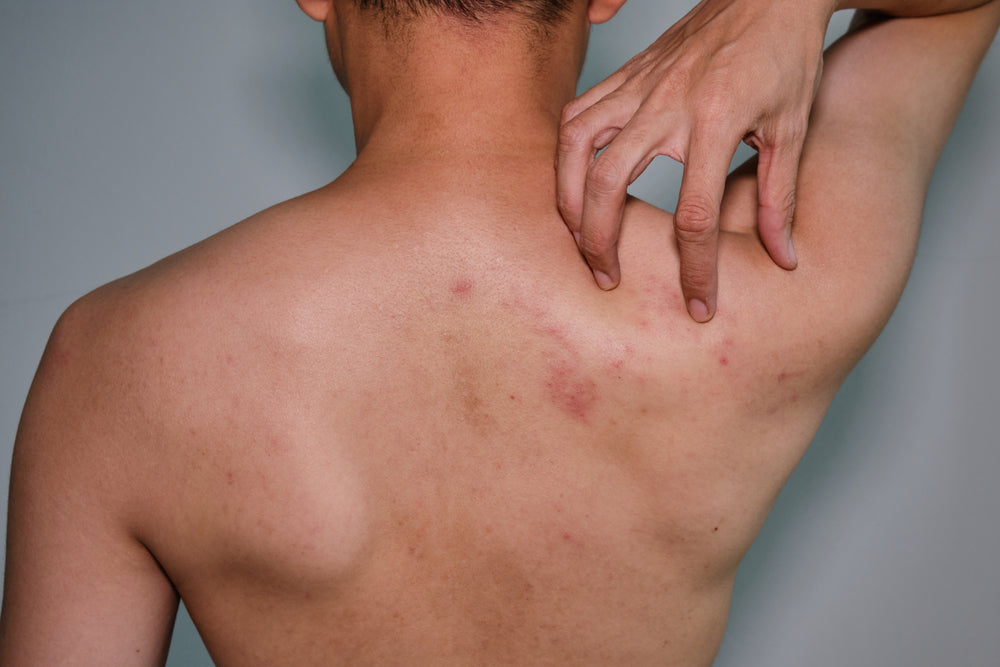Free U.S. Shipping On Orders Over $150

6 Surprising Causes of Body Acne on Your Chest, Back and Other Areas
Posted on
The mechanism behind facial and body acne is similar. Your skin’s pores get clogged by sweat, bacteria, dirt, oils and dead skin cells, resulting in a breakout. But some of the causes of body acne are different from facial acne and understanding them is essential in keeping your skin healthy.
In this post we discuss the most surprising causes of body acne and how to deal with them.
What Is Body Acne?
Body acne is a breakout that happens on any other area of your body other than your face. We talk a lot about facial acne, but acne breakouts can happen anywhere on your body. Body acne often occurs on the back and chest, but it can also affect your stomach, butt and even genitals.
Essentially, you can get body acne anywhere you have oil glands and hair follicles, which is everywhere on your skin except the palms of your hands and soles of your feet.
6 Surprising Causes of Body Acne
1. Friction and Pressure
Persistent friction and pressure on a particular area of the skin cause or worsen an acne breakout. This type of acne caused by mechanical means is called acne mechanica.
Acne mechanica appears as regular pimples with no blackheads or whiteheads. These pimples can later get inflamed, turning red and getting painful.
The location of acne mechanica tells you a lot about what’s causing it. If you often carry a heavy backpack, it may appear on your shoulders or your back. If you cycle a lot, it can appear on your thighs or around your forehead (because of the helmet). Bra straps can also cause friction acne.
What to do about it: Reduce friction and pressure on the affected area by lightening your backpack, getting a bra that’s gentler on your skin and taking off sports gear as soon as you are done playing. If it’s not possible to reduce or eliminate friction, use acne medication like salicylic acid to treat the breakout.
2. Sweat
Another type of body acne is sweat acne. It occurs when sweat clogs up your pores, along with other debris like dirt and dead skin cells, resulting in a breakout.
Sweat acne usually occurs on areas where you sweat the most like your back, under your boobs, on your butt or on your chest.
Similar to friction acne, sweat acne looks like regular pimples. It goes away once the sweat dries off and you take a shower. But it can also persist and get inflamed.
What to do about it: Wear breathable and sweat wicking clothes such as our antibacterial HercShirt. This keeps sweat off your skin. If you get night sweats, wear sweat-wicking pajamas and use sweat-wicking bedding.
3. Hormones
Hormonal acne typically appears on the face, but it can also appear on your body in various areas like the chest, back, neck and shoulders.
Women are the most affected by hormonal acne because of constant hormonal fluctuations during the menstrual cycle, pregnancy and menopause.
What to do about it: Beyond taking good care of your skin, the only other solutions to hormonal acne are acne medication and, in the case of menopause and hormonal disorders, hormone therapy.
4. Poor Skin Care
Most of us take far better care of our face than our body. We’ll have all these products to keep the face plump and smooth, but don't pay the same level of attention to the rest of the body.
The lack of proper moisturization, regular exfoliation and other aspects of good skin care increases the risk of body acne.
What to do about it: Give the same TLC to your body as you do your face. Keep it clean, exfoliate regularly and use a good quality moisturizer.
5. Bedding
Yes, your bed sheets or mattress can give you body acne. This usually happens because of poor bed hygiene. Your sheets accumulate dead skin cells, dirt, allergens, sweat, bacteria and other stuff.
When you go too long (more than a week) without changing sheets, this gunks transfers back onto your skin and clogs pores. If you are a back sleeper, you might get a breakout on your back. If you sleep on your stomach, it can occur on your chest or stomach.
What to do about it: Change your sheets, pillowcase and duvet cover at least once a week. If you are prone to acne, you often go to bed without showering or you sweat a lot at night, wash your linen 2-3 times a week.
6. Diet
Ever noticed that your chest or back acne correlates with the periods when you eat certain foods?
Researchers have found that high-glycemic index foods (those that spike blood sugar) can trigger acne breakouts on the face or body. These include highly processed foods and sugary foods and beverages.
What to do about it: Add lots of low glycemic index foods to your diet including vegetables, legumes, nuts, fresh fruits and oats.
Quick links
Contact
6063 Hudson Road #160
Woodbury, MN 55125
Yo@hercLeon.com
Leave a comment: